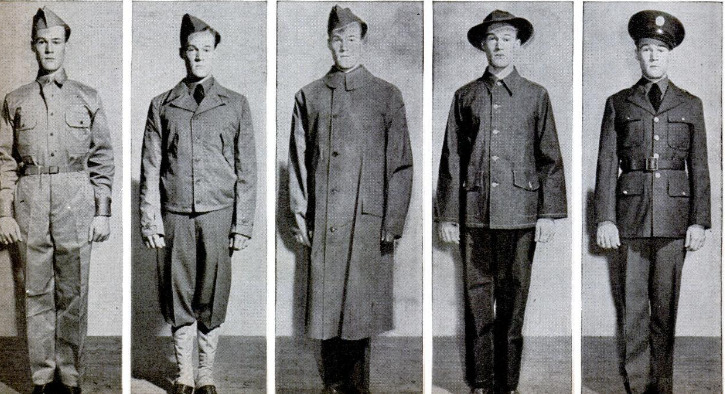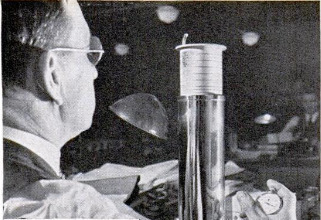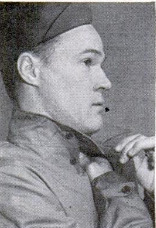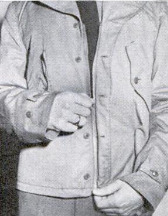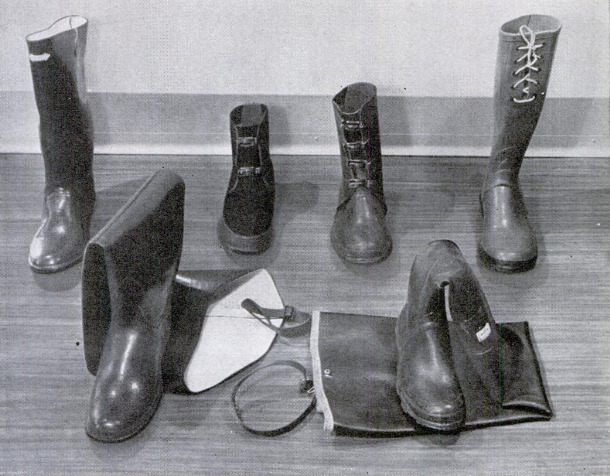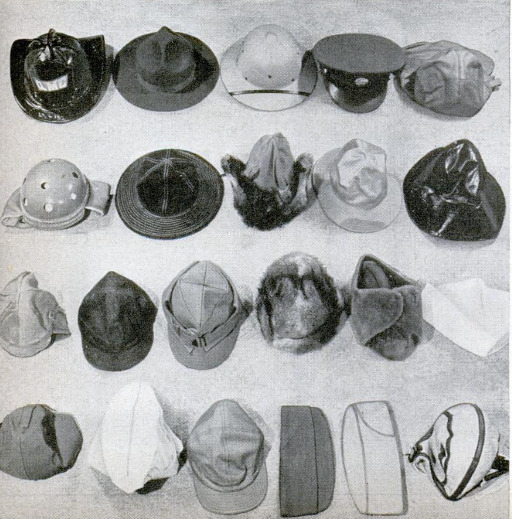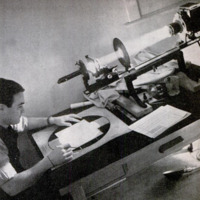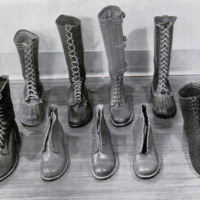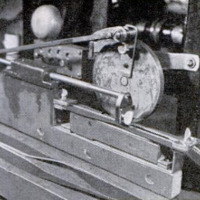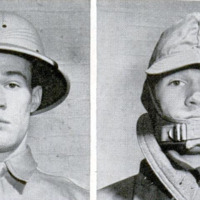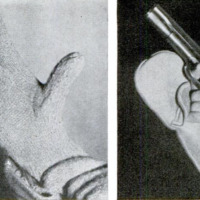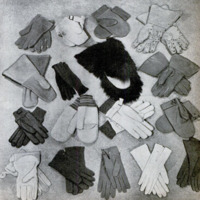-
Title (Dublin Core)
-
Wardrobes for soldiers
-
Article Title and/or Image Caption (Dublin Core)
-
Title: Wardrobes for soldiers
-
extracted text (Extract Text)
-
THE busiest haberdashery in the United
States today is the Army Quartermaster
Corps. It has the job of providing uniforms,
complete from underwear to overcoats and
from shoe laces to hats, for the entire en-
listed personnel of the Army.
‘That means a lot more than dealing out
a uniform with two pairs of pants to each
recruit, because the enlisted man in the
American Army is one of the best-dressed
soldiers in the world. He has different uni-
forms for summer and winter, for field work
and garrison duty, for ditch-digging and
parading. Specialists, such as mechanics,
cavalrymen, parachute and armored-force
troops, have, in addition to their
regular uniforms, extra outfits de-
signed to meet their particular
needs.
Add the specialized items to the
equipment that is issued to every
doughboy and it makes an impres-
sive list. The office of the Quarter-
master General in Washington, for
example, has samples of 22 kinds
of hats, 17 styles of gloves and mit-
tens, and 15 types of boots and
shoes, representing just a few of
the things that must be kept in
stock to supply the soldiers.
The glove list includes such vary-
ing designs as bearskin mittens for
troops in Alaska, fleece-lined horse-
hide mittens with slits across the
palms so a soldier can get his fin-
gers out to work a trigger without
taking the mittens off, asbestos gloves for
handling hot stuff, suede gloves for Army
nurses, and leather gloves with reénforce-
ments riveted on fingers and palms so
barbed wire can be handled without lacerat-
ing a soldier's hands.
Hats range from headpieces for tank driv-
ers and firemen to cloth-covered fiber hel-
mets for wear in the tropics. Shoes run
from hip boots (two styles) down to oxfords
for the nurses. There is even a special shoe
for Philippine scouts because the ordinary
service shoe doesn't fit their feet.
A list of garments the Q.M. department
‘must keep on hand reads like a mail-order
catalogue. Every soldier
gets, among other things,
woolen shirts and trous
sers for cold weather,
khaki ones for summer,
a wool-lined mackinaw for field work in win-
ter, blue denim trousers and jackets for
dirty work, and a heavy overcoat for “pute
ting on the dog” in cold weather.
One of the most popular items with the
soldiers is the new lightweight, wool-lined,
wind and water-repellent field jacket. It has
a belted and pleated back, slide fastener and
buttons on the front, and button flaps over
the pockets. The collar can be buttoned
tightly around the neck, or worn open.
‘When the first of these were issued recent-
ly, even the officers wanted some.
However, commissioned officers are
supposed to supply their own cloth-
ing, and the QM. Corps needed all
the jackets it could get for the en-
listed men.
For soldiers in mechanized out-
fits, a “monkey suit” has been de-
veloped that makes a soldier look
like a teddy bear, but does a good
job of keeping him warm and dry.
It is made in two pieces, with over-
all-type trousers and knitted bands
at ankles, wrists, neck, and waist.
Wind and water-repellent cloth are
used for the outer layer, with a
heavy wool lining. A helmet of the
same material, with a flap that ex-
tends down over the jacket collar to
protect the back of the wearer's
neck, and two-buckle arctics, com-
plete the outfit.
Since nothing is available commer-
cially that meets the Army require
ments, the Q.M. Corps develops its
own ideas and those of the Army in
general in designing soldiers’ cloth-
ing. Each of the many garments now
in use represents months, in some
cases years, of experimentation and
research.
The idea for a new type of gar-
ment usually originates in the en-
listed personnel or among the offi-
cers of the Army. When somebody
thinks that a change is in order, he
submits his suggestions to the Q.M.
department. Officers trained in tex-
tile schools, and civilian workers on
the Q.M. staff search the commercial
field for designs and fabrics. Then they
combine what they have found with the
Army suggestions and turn out an experi-
‘mental model. This is submitted to a techni-
cal board in Washington, representing all
branches of the service. If the board ap-
proves, the model goes to the general staff,
and finally to the Chief of Staff for a final
0.K.
After that a trial order is made up and
shipped to some outfit in the field for a
work-out. When the garments have been in
use long enough to see how good they are, a
~ report is submitted to the Q.M. Corps, pos-
sibly with suggestions for improvements.
Then general specifications are drawn up
and manufacturers are invited to bid on
large orders.
Most Army clothing is made by commer-
cial manufacturers from cloth, thread, but-
tons, and fittings supplied by the Army. The
QM. boys know just how many garments
can be turned out from a given amount of
cloth, down to the last yard, and the con-
tractor has to return even the scraps to the
Army after the job is done. These are
weighed and the weight added to that of
the garments to see that nothing is lost.
To make sure that it is getting the best
material for its needs, the Q.M. Corps main-
tains at its Philadelphia depot what is prob-
ably the best-equipped textile-testing labor-
atory in the country. There fabrics are
tested for strength, waterproof qualities, and
durability. Thread and cords are checked
for breaking strain, color, and even the
number of yards of thread per spool. Slide
fasteners are hooked to a machine devised
by the laboratory staff and opened and
closed 10,000 times to test them for wear.
Another ingenious machine developed by
the laboratory staff is used to test the
warmth-retaining characteristics of various
fabrics. It consists of an electrically heated
cylinder around which the cloth is clamped.
The amount of current required to keep the
cylinder at body temperature for a given
period of time while a fan is blowing cold air
against the cloth is measured carefully. By
comparison with cloth which has aiready
been tested in the field, this gives an index
of how effective the new fabric will be.
-
Contributor (Dublin Core)
-
David M. Stearns (article writer)
-
Language (Dublin Core)
-
Eng
-
Date Issued (Dublin Core)
-
1941-06
-
pages (Bibliographic Ontology)
-
90-95
-
Rights (Dublin Core)
-
Public domain
-
Archived by (Dublin Core)
-
Sami Akbiyik
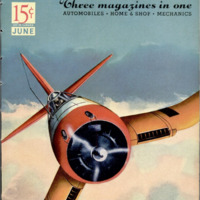 Popular Science Monthly, v. 138, n. 6, 1941
Popular Science Monthly, v. 138, n. 6, 1941

